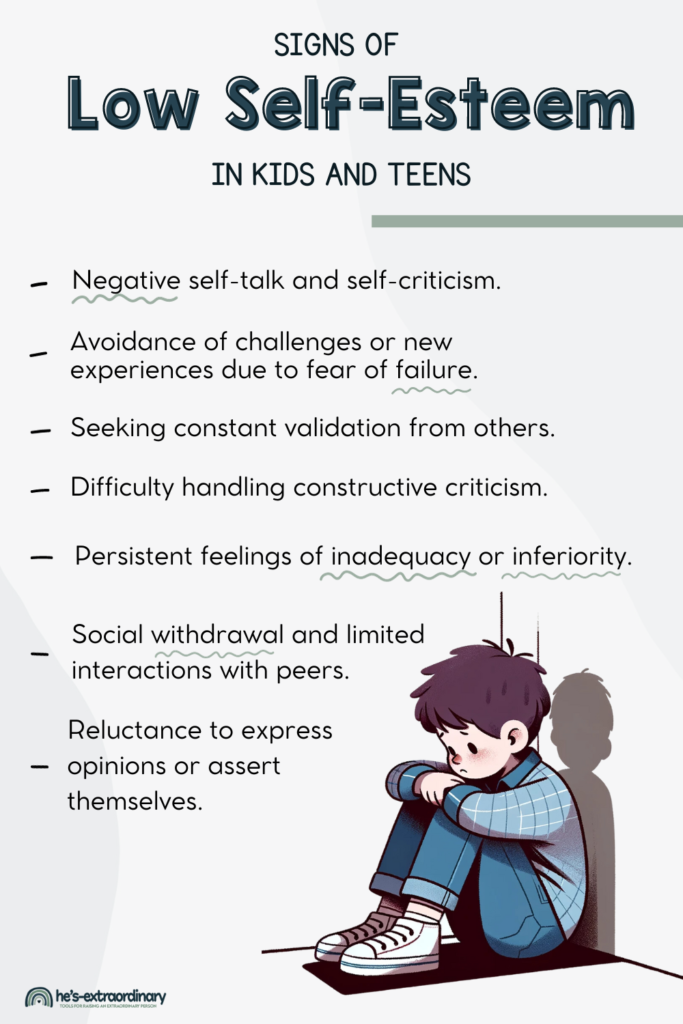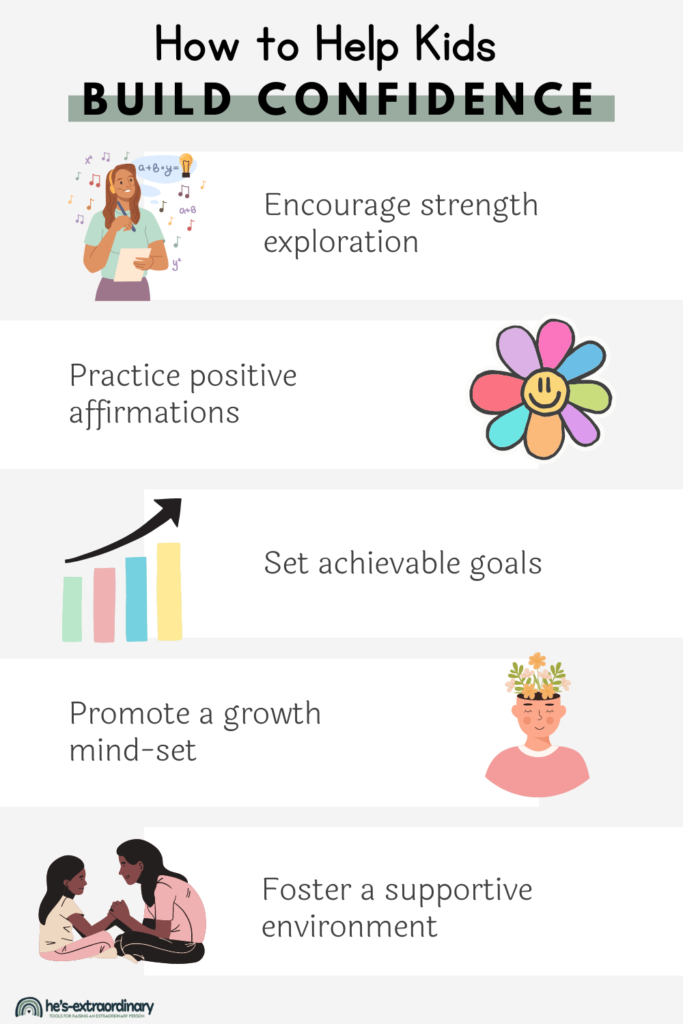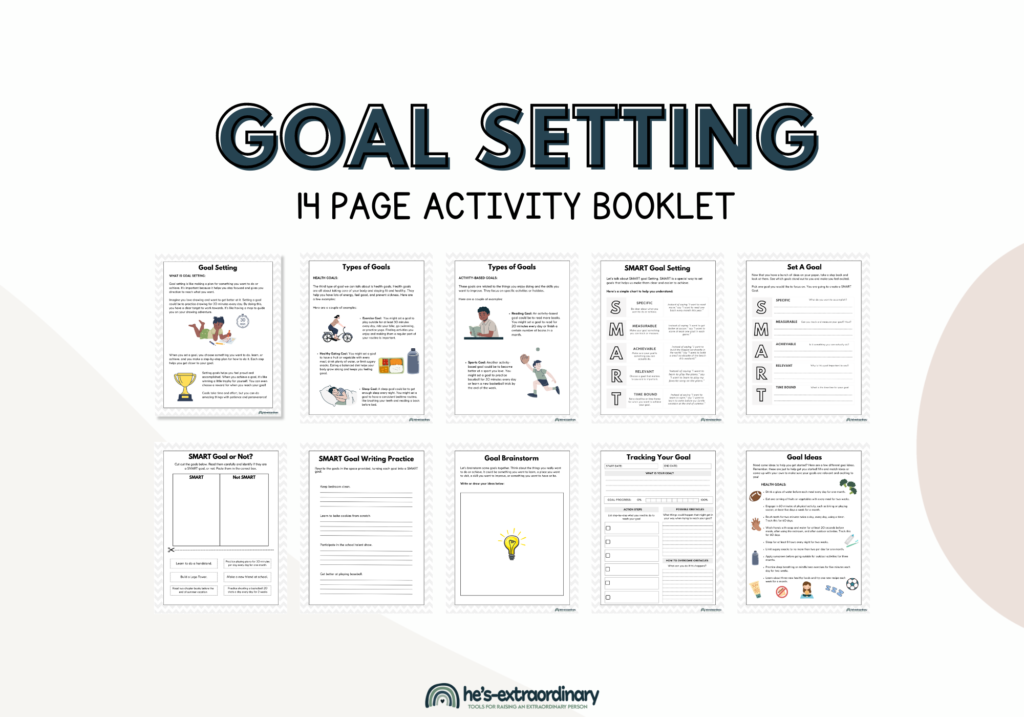Boosting Self-Esteem: 5 Ways to Build Confidence in Kids
What’s inside this article: A quick overview of signs kids are struggling with low self-esteem, the benefits of building positive self-esteem, and five ways to successfully build confidence in kids.
Disclaimer: This post contains affiliate links.
Building confidence in our children is crucial for their overall development and well-being in a world that constantly challenges them. As parents, guardians, or educators, we play a significant role in shaping their self-esteem.
In this article, we will explore five ways to help boost kids’ self-esteem, providing them with a solid foundation for success and happiness.
Signs Kids Are Struggling with Low Self-Esteem:
Before going over the confidence-building activities, it’s important to cover the signs that may indicate low self-esteem in children so you know how to recognize them.
These signs may include:
- Negative self-talk and self-criticism.
- Avoidance of challenges or new experiences due to fear of failure.
- Seeking constant validation from others.
- Difficulty handling constructive criticism.
- Persistent feelings of inadequacy or inferiority.
- Social withdrawal and limited interactions with peers.
- Reluctance to express opinions or assert themselves.
Recognizing these signs is the first step toward addressing and improving a child’s self-esteem.

The Benefits of Confidence and Boosting Self-Esteem in Kids:
Confidence is a powerful tool that empowers children to navigate life’s challenges and develop resilience.
Here are some key benefits of building confidence in kids:
- Improved academic performance: Kids and teens with high self-esteem are more likely to actively engage in learning, take risks, and persist in the face of setbacks, leading to improved academic achievements.
- Positive social interactions: Building confidence allows children to develop healthy relationships, assert themselves effectively, and easily navigate social situations. This strengthens their ability to communicate, collaborate, and establish meaningful connections.
- Emotional well-being: Children with higher self-esteem are generally more resilient and better equipped to manage stress, anxiety, and negative emotions. This enhances their overall emotional well-being and promotes a positive mindset.
- Self-motivation and independence: Confidence empowers children to set goals and become self-motivated individuals. This cultivates independence and prepares them for future success.
Now, let’s dive into the five ways to help build confidence in kids.
How to Build Confidence in Kids:
There are many different ways to help build confidence in kids. Here are five strategies parents can implement to help their children develop self-confidence.

1. Encourage Strengths Exploration
When children engage in activities that align with their strengths, they experience a sense of accomplishment and fulfillment, which builds their confidence.
Here’s how you can effectively encourage strengths exploration in your child:
Create a supportive environment:
Create an environment where your child feels safe and encouraged to explore their interests and talents. Let them know you value their individuality and that having different strengths than others is okay. Provide them with a nurturing space to express themselves without fear of judgment or criticism.
There’s more details tips on successfully building a supportive environment below.
Observe and listen:
Pay attention to your child’s natural inclinations and interests.
Observe what activities or subjects they gravitate towards and what brings them joy.
Listen to their ideas, dreams, and aspirations. You can gain valuable insights into their potential strengths and talents by simply being attentive.
Provide a range of opportunities:
Expose your child to various activities and experiences. Offer opportunities for them to explore different domains such as sports, arts, music, or academic pursuits.
This exposure allows kids to discover things that resonate with them and what they naturally excel at.
Encourage youre child to try new things and be open-minded, but don’t force them into activities they aren’t passionate about.
Encourage their interests:
Once your child shows interest in a particular activity or area, provide support and resources to nurture their skills.
Enroll them in classes, workshops, or clubs related to their interests. Offer guidance and encouragement as they explore and develop their abilities. Be their advocate and cheerleader throughout their journey.
Focus on effort and growth:
Emphasize the value of effort and growth over immediate results and talent.
Encourage your child to embrace challenges, persevere, and learn from setbacks. Teach them that skills and abilities can be developed through practice and dedication.
They will build resilience and a growth mindset by focusing on the process rather than just the outcome.
Celebrate achievements and milestones:
When your child achieves milestones or makes progress in their chosen activities, celebrate those achievements.
Acknowledge their hard work, dedication, and improvement. This positive reinforcement reinforces their confidence and motivates them to continue exploring and developing their strengths.
Provide positive role models:
Introduce your child to positive role models who excel in areas aligned with their interests. It could be through books, videos, or real-life interactions.
Exposing them to individuals who have succeeded by leveraging their strengths can inspire and motivate them to pursue their passions, too.
Encourage collaboration and teamwork:
Engage your child in activities that require collaboration and teamwork. This helps them see the importance of their contributions and how their unique strengths can complement those of others.
Working as a team also builds a sense of belonging and confidence in their abilities to contribute positively. This simultaneously helps build social skills as well.
You empower your child to discover their passions and talents by actively encouraging the exploration of strengths.
This process instills a sense of purpose, accomplishment, and self-assurance. As kids recognize, develop, and embrace their strengths, they start gaining more confidence.
2. Practice Positive Affirmations
One effective way to build confidence in kids is by teaching them the power of positive self-talk by using positive affirmations.
Positive affirmations are statements that focus on one’s positive qualities, abilities, and achievements.
By encouraging your child to engage in this practice, you can help them develop a strong sense of self-belief and counteract negative self-talk.
Some ways to practice positive affirmations include:
- Introduce the concept of positive affirmations: Start by explaining to your child what positive affirmations are and how they can impact their self-esteem. Help them understand that the words they say to themselves have a significant influence on how they feel and perceive themselves.
- Identify positive qualities and achievements: Sit down with your child and guide them in identifying their strengths, positive attributes, and achievements. Encourage them to reflect on their strengths, talents, and past accomplishments. This exercise helps them recognize their unique qualities and builds a foundation for positive self-talk.
- Create personalized affirmations: Once your child has identified their positive qualities, work together to create personalized affirmations. These affirmations should be specific, positive, and empowering. For example, if your child is good at solving puzzles, an affirmation could be, “I am a clever problem solver.”
- Repeat affirmations regularly: Encourage your child to repeat their affirmations daily, ideally in front of a mirror. This practice allows them to reinforce positive self-talk and internalize the affirmations on a deeper level. Make it a fun and engaging activity by doing it together or incorporating it into their daily routine.
- Reinforce affirmations with positive feedback: As your child engages in positive self-talk, provide regular reinforcement and positive feedback. Acknowledge their efforts, growth, and achievements, aligning your feedback with the affirmations they are practicing. This reinforcement helps solidify their self-belief and strengthens their confidence.
- Address negative self-talk: It’s essential to address any negative self-talk your child may exhibit. Encourage them to recognize when they are engaging in negative thoughts or self-criticism and gently redirect them toward their affirmations. Teach them to challenge negative beliefs and replace them with positive affirmations.
- Adapt affirmations over time: As your child grows and develops, their strengths and accomplishments may change. Encourage them to adapt their affirmations accordingly to reflect their current qualities and achievements. This allows their affirmations to stay relevant and meaningful throughout their personal journey.
Your child will internalize positive self-talk and develop a resilient and positive mindset by consistently practicing positive affirmations. Over time, they will build a strong sense of self-belief, allowing them to face challenges and embrace their unique qualities and abilities confidently.
3. Set Achievable Goals
Setting achievable goals is an effective way to boost self-esteem and build confidence in kids.
By helping your child set realistic goals and breaking them down into manageable steps, you can empower them to develop problem-solving skills, perseverance, and a sense of achievement.
This printable 14-page goal-setting booklet can guide you and your child to learn more about effective goal-setting and help you choose and track your own personal goals together.
Here’s how to help your child with goal setting:
Discuss goal setting:
Discuss what goal setting means and why it’s important.
Help your child understand that goals provide direction, motivation, and a sense of purpose. Encourage them to think about what they want to achieve and why it’s meaningful to them.
Teach realistic goal setting:
Emphasize the importance of setting realistic and attainable goals.
Help your child understand that while it’s essential to aim high, setting overly challenging or unrealistic goals can lead to discouragement and frustration. Guide them in finding a balance between ambition and feasibility.
Break goals into manageable steps:
Once your child has identified a goal, work with them to break it down into smaller, actionable steps.
Help them analyze the process required to achieve their goals and create a timeline or checklist. Breaking goals into manageable steps makes them less daunting and increases the likelihood of success.
Build problem-solving skills:
Encourage your child to think critically and develop problem-solving skills along the way.
When they encounter obstacles or setbacks, guide them in brainstorming solutions and alternative approaches. Teach them that setbacks are a natural part of the process and provide valuable learning opportunities.
Celebrate milestones and progress:
Celebrate your child’s progress and achievements as they work towards their goals.
Recognize and acknowledge their efforts, no matter how small. Regularly check in on their progress and provide positive reinforcement.
Celebrating milestones reinforces their confidence, motivates them to keep going, and cultivates a sense of accomplishment.
Adjust goals as needed:
Help your child understand that sometimes goals need adjusting because circumstances can change.
Encourage flexibility and adaptability. If they encounter unforeseen challenges or their interests evolve, support them in reevaluating and modifying their goals.
Encourage embracing challenges:
Teach your child that challenges are opportunities for growth.
Encourage them to step out of their comfort zone and embrace challenges as chances to learn and develop new skills. Be their cheerleader and provide support, reminding them that they are capable of overcoming obstacles.
Lead by example:
Demonstrate goal-setting behaviors in your own life.
Share your own goals, both big and small, and discuss your progress with your child. You could even set a goal to work on together.
By modeling the process of setting and achieving goals, you’ll inspire your child and show them that goal setting is a lifelong skill.
By guiding your child in setting achievable goals and supporting them throughout the process, you empower them to develop problem-solving skills, resilience, and a sense of accomplishment.
As they experience success and see their efforts paying off, their self-esteem will grow, and they will be motivated to tackle new challenges confidently.
4. Promote a Growth Mindset
Teaching about the power of a growth mindset is valuable for building confidence in kids and fostering a love for continuous learning.
By instilling the belief that abilities and intelligence are developed through effort and practice, you empower your child to embrace challenges, view mistakes as learning opportunities, and build resilience.
Here are some ways to promote a growth mindset:
Explain the concept of a growth mindset:
Start by explaining to your child what a growth mindset means. Help them understand that their abilities, talents, and intelligence are not fixed traits but improvable through effort, practice, and learning from mistakes.
Emphasize that their potential is not predetermined and that they can grow and develop their skills.
Emphasize the importance of effort:
Encourage your child to recognize and value the effort they put into their pursuits.
Hard work, practice, and dedication are necessary for growth and improvement. Help them understand that success is not solely determined by innate talent but by the willingness to invest time and effort in their endeavors.
View mistakes as learning opportunities:
Encourage your child to embrace mistakes as valuable learning opportunities.
Teach them that making mistakes is a natural part of the learning process and a chance to gain new insights and improve. Emphasize that mistakes do not define their worth or abilities but provide meaningful feedback for growth and development.
Highlight examples of perseverance and resilience:
Share stories or examples of other people who achieved success through perseverance and resilience.
Help your child understand that setbacks and challenges are inevitable, but with determination and resilience, they can overcome obstacles and achieve their goals. Inspire them with examples of both famous figures and people in their lives who have demonstrated these qualities.
This list of famous people with autism might help you choose some famous people that can act as role models and inspiration.
Encourage a love for continuous learning:
Build a curiosity and passion for learning in your child.
Encourage them to explore new subjects, interests, and hobbies. Provide them with age-appropriate books, resources, and experiences that stimulate their curiosity and love for knowledge.
Demonstrate that learning is a lifelong journey and something to be enjoyed by learning new things along side them.
Provide specific feedback and praise:
When providing feedback or recognition, focus on effort, progress, and specific strategies your child uses.
Acknowledge their hard work, perseverance, and resilience. By emphasizing their growth and improvement rather than just the outcome, you reinforce their belief in their ability to develop their skills.
Be a role model:
Model a growth mindset yourself. Share stories of your challenges and setbacks and how you overcame them. Show your child that you are continuously learning and growing, too – even as an adult.
By promoting a growth mindset, you empower your child to see challenges as opportunities for growth, develop resilience, and develop a love for continuous learning.
This mindset shift helps build confidence in kids.
As kids develop a growth mindset, they become more resilient, adaptable, and open to new experiences, setting the stage for lifelong success and fulfillment.
You can find tons of growth mindset printables on the Big Life Journal website.
5. Create a Supportive Environment
The good news is, if you’ve been implementing the last four strategies for building confidence in kids, you’re already providing your child with a supportive environment.
When children feel safe expressing themselves without fear of judgment, they are more likely to develop a positive self-image and self-esteem.
Here are some tipcs for successfully creating a supportive environment:
- Establish open communication: Encourage open and honest communication with your child. Create a safe space where they feel comfortable sharing their thoughts, feelings, and experiences. Listen actively, without judgment, and validate their emotions. Let them know that their voice matters and that you are there to support them.
- Praise and constructive feedback: Provide praise and recognition for your child’s efforts and achievements. Once again, remember to focus on their progress and improvements rather than solely on outcomes. Additionally, offer constructive feedback that is specific, actionable, and delivered in a supportive manner. This will help your child understand how they can improve while highlighting their strengths.
- Encourage healthy risk-taking: Encourage your child to step out of their comfort zones and take healthy risks, such as trying new activities, exploring different interests, and pursuing things they find challenging. Assure them it’s okay to make mistakes and that failures are opportunities for learning and growth. By encouraging healthy risk-taking, you foster resilience, confidence, and a sense of adventure in your child.
- Encourage autonomy and decision-making: Empower your child to make decisions and take ownership of their choices. Offer guidance and support as needed, but allow them to experience the natural consequences of their actions. Encouraging autonomy helps build confidence, decision-making skills, and a sense of responsibility. It shows them you value their opinions and choices and trust them to make responsible decisions.
- Create a non-judgmental atmosphere: Create an atmosphere free from judgment and comparison. Encourage acceptance and understanding of individual differences. Teach your child to respect others and embrace diversity. By creating a non-judgmental environment, you help your child develop self-acceptance, empathy, and an appreciation for the uniqueness of others.
- Be a positive role model: Be a positive role model for your child. Demonstrate self-compassion, resilience, and a growth mindset in your actions and words. Show them how you handle challenges, setbacks, and conflicts with grace and determination. Model healthy self-esteem, positive self-talk, and a supportive attitude toward others.
If your child has pathological-demand avoidance, you can find some additional PDA specific tips for building a supportive home environment here.
Creating a supportive home environment forms the foundation for your child to develop confidence, self-esteem, and resilience.
They will feel empowered to express themselves, take healthy risks, and celebrate their achievements.
This supportive atmosphere nurtures their overall well-being and sets them up for success in all aspects of life.
Building confidence in kids is a vital aspect of their personal growth and development and sets them up for life-long success.
It can take hard, continuous effort as a parent to help a child struggling with low self-esteem, but the payoff is tremendous. Remember to be patient, consistent, and supportive throughout your child’s journey. You’ll empower them to believe in themselves and embrace their full potential.
Your child will grow into a confident, resilient, and successful individual with your guidance and encouragement.


